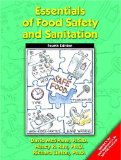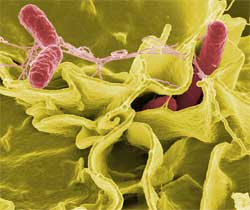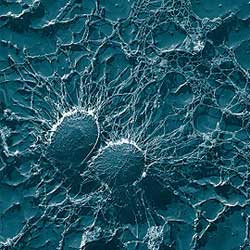The 4 Most Common Food Illnesses; Identify, Treat & Prevent
At some point during any discussion or practice of food indepedence, preparedness or storage, any reasonable person is going to express concerns about food related illnesses. I firmly believe that most food borne illnesses are the results of avoidable factors such as negligant preparation, inadequate storage and substandard living conditions. As a case in point, I have never experience so much as an upset stomach as a result of food prepared and eaten while hiking. Every case of food borne illness I have endured has been at the hands of resteraunters and other business food services. Personal opinions about the quality of our food industry (recalls, scandals and outright criminal negligance) aside, some knowledge for the home & farm never hurts.
Salmonellosis
Caused by the Salmonella bacteria; a ide-spread in nature and lives and grows in the intestinal tracts of human beings and animals. It is easily the most commonly known and experienced “food poisoning” for people in the United States.
Food Sources: For most people, Salmonellosis is associated with incorrectly prepared poultry, egg and dairy products, but several other possible means of infection exist such as: Beef, handling live reptiles & rodents and secondary exposure from contaminated fruits and vegetables.
Symptoms: Sever headache, followed by vomiting, diarrhea, abdominal cramps, and fever. In extreme cases, victims may suffer bloody diarrhea with mucus and rose spots on the skin. Onset time is usually within 12 to 36 hours of exposure with a duration of 2 to 7 days. Infants, elderly, and persons with compromised immune systems are most susceptible. Severe infections cause high fever and may even cause death, though this is rare in healthy individuals with adequate access to modern amenities.
Prevention: Salmonellae in food are destroyed by heating the food to 140°F and holding for 10 minutes or to higher temperatures for less time; for instance, 155°F for a few seconds. Refrigeration at 40°F inhibits the increase of Salmonellae, but they remain alive (dormant) in untreated foods in the refrigerator or freezer, and even in dried foods.
Perfringens
Clostridium Perfringens is a spore-forming bacteria that grow in the absence of oxygen. The bacteria arrives as a food contaminate for a wide vareiety of primary and secondary sources ranging from decaying vegetation to marine sediment to the intestinal tracts of animals. Along with Salmonella, Perfringens collectively forms the bulk of “food poisoning” that most people will experience during the course of their lives.
Food Sources: Stews, soups, or gravies made from poultry or red meat.
Symptoms: Nausea without vomiting, diarrhea, acute inflammation of stomach and intestines. Unlike Salmonella, vomiting and fever are unusual in cases of Perfringens.
Prevention: To prevent growth of surviving bacteria in cooked meats, gravies, and meat casseroles that are to be eaten later, cool foods rapidly and refrigerate promptly at 40°F or below, or hold them about 140°F.
Staphylococcus
Staphylococcus is a problematic bacteria because of its resistant to heat. The bacteria produces a toxin as a byproduct of its growth that is also resistant break down from heat, compounding the problem A variety of harmless strains exist but the problematic strain is very common as well, originating in soil and quickly able to contaminate improperly stored food.
Food Sources: Custards, egg salad, potato salad, chicken salad, macaroni salad, ham, salami, and cheese. Transmitted by food handlers who carry the bacteria and by eating food containing the toxin.
Symptoms: Vomiting, diarrhea, prostration, abdominal cramps. These are generally mild and often attributed to other causes.
Prevention: Growth of bacteria that produces toxin is inhibited by keeping hot foods above 140°F and cold foods at or below 40°F. Toxin is destroyed by boiling for several hours, or heating the food in a pressure cooker at 240°F for 30 minutes.
Botulism
Caused by the action of the Clostridium botulinum bateria. Spore-forming organisms that grow and produce toxin in the absence of oxygen, such as in a sealed container. Botulism is the most serious of the common food poisoning ailments and should be considered a medical emergency if suspected.
Food Sources: Canned foods with low-acid content and smoked fish. Transmitted by eating food containing the toxin.
Symptoms: Double vision, inability to swallow, speech difficulty, progressive respiratory paralysis. Fatality rate is high, about 65% in the United States. Onset time is usually within 12 to 36 hours or longer with a duration of 3 to 6 days.
Prevention: Bacterial spores in food are destroyed by high temperatures obtained only in the pressure canner. More than 6 hours is needed to kill the spores at boiling temperature (212°F). The toxin is destroyed by boiling for 10 to 20 minutes; time required depends on kind of food.
Additional Research:
 |




Leave a Reply